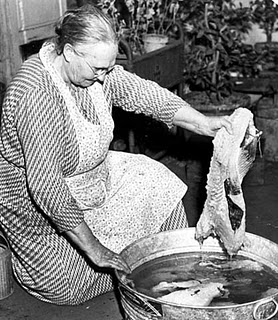
Good Morning Gloucester FOB Al Bezanson wrote a very funny response to my post of several days ago, Mystery of the Disappearing Soap, which if you don’t read the GMG comment thread, you would have missed. Al’s response, “It is undoubtedly a Norway rat (Rattus norvegicus). Only creatures with ethnic roots from that region take pleasure in dining on soap. I know this because I have visited that country and had the experience of eating lutefisk. Be warned — we are approaching the season when you may be offered this delicacy.”
Never having had the occasion to try lutefisk, I wanted to know more about it but, after reading only the wiki article, needless to say I don’t think I ever will.
From wiki “Lutefisk is made from aged stockfish (air-dried whitefish) or dried/salted whitefish (klippfisk) and lye (lut). It is gelatinous in texture, and has an extremely strong, pungent odor. Its name literally means “lye fish.”
The process is described further:
“The first treatment is to soak the stockfish in cold water for five to six days (with the water changed daily). The saturated stockfish is then soaked in an unchanged solution of cold water and lye for an additional two days. The fish swells during this soaking, and its protein content decreases by more than 50 percent producing a jelly-like consistency. When this treatment is finished, the fish (saturated with lye) has a pH value of 11–12 and is therefore caustic. To make the fish edible, a final treatment of yet another four to six days of soaking in cold water (also changed daily) is needed. Eventually, the lutefisk is ready to be cooked.”
I can’t resist including several of Garrison Keillor’s hysterical comments on lutefisk, also found in the same wiki article:
“Every Advent we entered the purgatory of lutefisk, a repulsive gelatinous fishlike dish that tasted of soap and gave off an odor that would gag a goat. We did this in honor of Norwegian ancestors, much as if survivors of a famine might celebrate their deliverance by feasting on elm bark. I always felt the cold creeps as Advent approached, knowing that this dread delicacy would be put before me and I’d be told, “Just have a little.” Eating a little was like vomiting a little, just as bad as a lot.”
and
“Lutefisk is cod that has been dried in a lye solution. It looks like the desiccated cadavers of squirrels run over by trucks, but after it is soaked and reconstituted and the lye is washed out and it’s cooked, it looks more fish-related, though with lutefisk, the window of success is small. It can be tasty, but the statistics aren’t on your side. It is the hereditary delicacy of Swedes and Norwegians who serve it around the holidays, in memory of their ancestors, who ate it because they were poor. Most lutefisk is not edible by normal people. It is reminiscent of the afterbirth of a dog or the world’s largest chunk of phlegm.
This morning Al posted a more detailed account of his experience with lutefisk.
“As sleuth David Simmons pointed out those tooth marks suggest mouse, but until this case is concluded I would at least maintain Rattus norvegicus as a critter of interest. Perhaps I was a bit hasty in assigning the blame. Who knows, r n may have actually decided to immigrate to the New World to escape Viking cuisine.
In connection with this I will relate how I came to know about lutefisk. It was 1966, at the Grand Hotel in Tromso, and following the customary social hour, or two, I sat down to dine with a local fellow. I had been poking about the country for several weeks on fishery matters and fancied myself to be quite knowledgeable about seafood. He took the cue and ordered up a lutefisk dinner for me. I’ll say that Garrison Keillor was spot on with his descriptions of this delicacy. While I waited for my substitute entrée Lars told of the recipes used by backyard lutefisk makers. Old bathtubs were in demand for the process and I thought he said soaking times were measured in months, not days. This is all vivid in my memory – perhaps in the same part of my brain that stores details of where I happened to be at the time of catastrophic events.
And Fred – thanks for your invitation – Phyllis and I will be paying you a visit.”
My note: The Norway rat (Rattus norvegicus), also known as the brown rat, is native to northern China. The species found its way to Eastern Europe by the early eighteenth century. By the year 1800, they occurred in every European country. First sightings of R. norvegicus in the New World occur in the 1770’s as ship stowaways. Today, Norway rats can be found on every continent except Antarctica.
Images courtesy google image search

